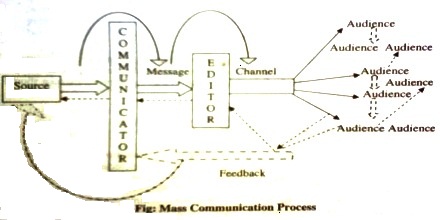Mass Communication Process
The communication process consists of a series of stages by which the message is transmitted from sender to receiver. The usual process of communication includes sender, encoding, message, channel, receiver, decoding, and feedback. The mass communication process also entails some sequential steps to transmit a message. However, the process of mass communication is somewhat different from interpersonal communication or face-to-face communication process. Researchers have identified four elements of the mass communication process. These are:
- Communicator → Encoder
- Message → Symbol
- Channel → Mass media
- Audience → Decoder
In the research language, the communicator is called an encoder; the message is called a symbol; the channel is called mass media, and the audience is called a decoder.
In mass communication, feedback, or reaction of the audience can occur in numerous ways. You can think of a large group of anonymous and heterogeneous people as either the general public or a segment of the general public. The receivers can send their response either to the communicator or the source of information or to the editor. If the communicator gets the receiver’s feedback, he sends it to the sources of information through another channel. Channels of communication include broadcast television, radio, social media, and print.
In the same way, the editor can also send the receiver’s response to the communicator by employing another medium. The sender of the message is usually a professional communicator that often represents an organization. The receivers can also exchange their responses to each other. Audiences of mass communication are likely to exhibit diverse reactions to the same message. Mass communication is an expensive process. Unlike interpersonal communication, feedback for mass communication is usually slow and indirect.
In mass communication, a professional communicator collects a message from the source and then transmits it to the audiences through a channel. The channels or media of mass communication are under the control of the editor. The presence of indirect feedback can also be observed in the mass communication process. From this viewpoint, the mass communication process can be visualized in the following way:

The process is being discussed below:
Source: Mass communication process begins with a specific source that has a message. The source can be an individual, an institution, a company, or a government.
Communicator: The second element of the process is a communicator who collects a message from the source. A communicator is also termed as the encoder. He plays a vital role in the mass communication process. He is a professional, trained and experienced person who develops the message in a way that the intended receiver can understand. A very simple piece of information may get enormous appeal to the audience due to the communicator. The communicator may be a reporter, journalist, lyricist, scriptwriter, author, official spokespersons, and so on.
Message: Message is the actual information or news to be communicated to the audience. The message may be a movie, a novel, a recorded song, and a billboard advertisement.
Channel: The channels are the mass media. These are the vehicles that transmit the message to the audience. Media of mass communication are newspapers, magazines, posters, leaflets, radio, television, films, etc.
Editor: Once a message is developed and the channel of transmission is selected, it is handed over to the editor. An editor is also an expert person. He controls the channel of mass communication. He also reviews the message of the communicator to ensure successful transmission of the message through the selected channel.
Audience: The audience is the ultimate recipient of the message of mass communication. They are large, diverse, and heterogeneous in nature. Audiences differ in relation so that education, age, gender, income, profession, social status, religion, beliefs, values, opinions, etc. Some of the audiences receive the message directly while others indirectly. It is also seen that some audiences are attentive while some ate inattentively.
In mass communication, feedback, or reaction of the audience can occur in numerous ways. The receivers can send their response either to the communicator or to the source of information or to the editor. If the communicator gets the receivers’ feedback, he sends it to the sources of information through another channel. In the same way, the editor can also send the receivers’ response to the communicator by employing another medium. The receivers can also exchange their responses to each other. The feedback or reaction of the audiences depends on their learning, experience, ideologies, and group affiliations. Audiences of mass communication are likely to exhibit diverse reactions to the same message.















